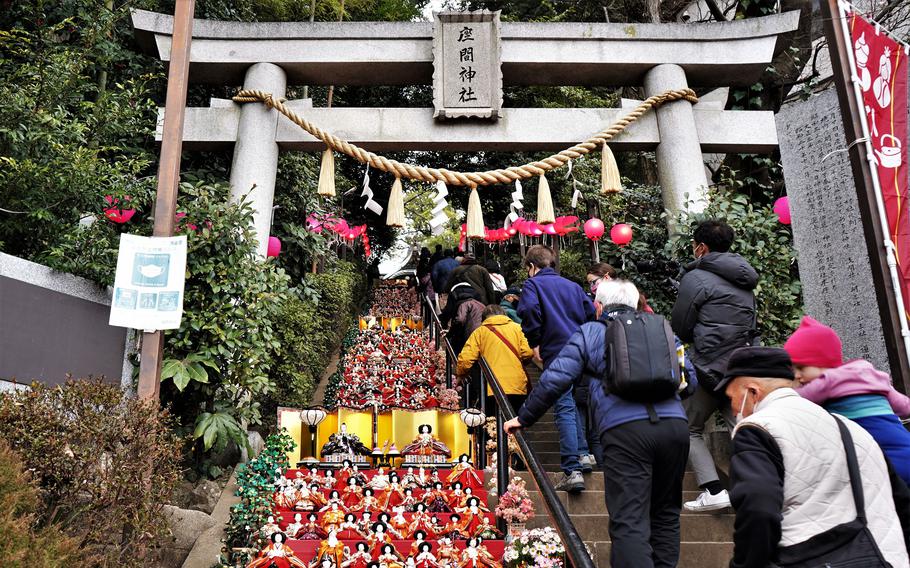
People climb Zama Shrine's steps, decorated with hundreds of ornate dolls, on a Japanese holiday known as Girls' Day, March 3, 2023. (Claire Jenq/Stars and Stripes)
CAMP ZAMA, Japan — Once a year, hundreds of ornate dolls decorate the steps of a Shinto shrine near the U.S. Army’s headquarters in Japan.
And every year on that day, March 3, called Hinamatsuri, or Girls’ Day, the Army Community Service at Camp Zama hosts a walking tour of Zama Shrine for military families.
On this holiday, Japanese families pray for the happiness and success of their girls. It’s marked by elaborate displays of dolls, or hina, that represent the imperial family.
This year, for the first time, residents of Naval Air Facility Atsugi arrived via shuttle bus to join the tour. Sixty people made the trip this year, said Maiki Mayhew, a community service tour coordinator.
The hundreds of dolls in Zama Shrine’s collection include emperors, empresses and their courtiers in traditional, multilayered robes modeled after royal wardrobes of the Heian period.
The dolls are exhibited in tiers on a vibrant red backdrop, against which visitors photograph their daughters.
Refreshments are served: hot amazake, a slightly fermented, alcoholic rice drink; and botamochi, a dessert of glutinous rice and sweet red beans.
For some, the bright displays evoke feelings of home.
Keikoa Villarin, an Army veteran and spouse of a military contractor newly stationed at Camp Zama, said the Girls’ Day celebration reminded him of his family’s Hinamatsuri celebrations while growing up in Hawaii.
About 14% of the population in Hawaii claims Japanese ancestry, according to the National Geographic Society, and many traditional Japanese holidays have been adapted by residents of the Aloha State. Some display the traditional hina dolls, while others instead present their daughters with mochi and little candies.
Army spouse Audrey Sikes and her family made their own traditions to celebrate Hinamatsuri by making pink pancakes for breakfast. The Sikes family arranged to attend the event with other homeschooling military families nearby who had connected through Facebook.
Army spouse Jennifer Thomas joined the tour for the second year in a row. Last year, the Hinamatsuri at Zama was her family’s first outing in Japan, which smoothed their arrival at their new home. She loved the experience so much, she said, that she had to return this year.
Zama Shrine holds more than 1,000 dolls in its collection, although no formal count has been done, according to a geki, or male shrine attendant, at Zama. The oldest set of hina in the collection is from the early to mid-Edo period (1716-1735) and is displayed once a year inside the shrine’s main building.